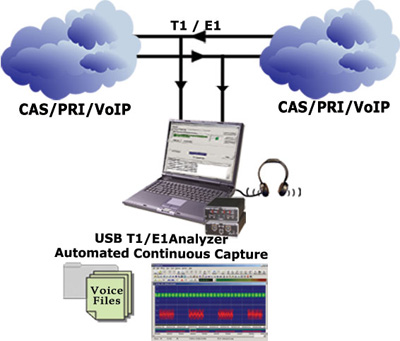Newsletter: GL Enhances T1 E1 Applications with Automated Continuous Capture (ACC)
Welcome to another February issue of GL Communications' Newsletter providing information about Automated Continuous Capture - The latest enhancement introduced to our versatile T1 E1 Products.
Overview
Our customers asked for an application that can non-intrusively record T1 E1 traffic continuously for an indefinite period of time, but flexible enough to have access to the captured data at near real-time or regular intervals. We developed Automated Continuous Capture, or ACC. It has wide applications to many areas, a few examples are mentioned below:
- Unattended capture of all traffic for an extended period of time for the purpose of capturing an abnormal event
- Capture for purposes of fraud detection, billing, or verification
- Capture for the purpose of replay of real world traffic in the lab
- Capture with near real-time analysis of captured data for a variety of voice and data applications

Important Features
Automated Continuous Capture is an optional application for GL's USB based or PCI Card based T1 E1 Analyzers. It permits non-intrusive capturing of T1 E1 data on (any one or all) T1 E1 channels to user-defined files. The data captured is saved as seamless chunks of data in "contiguous" files. "Chunks" can be defined as fixed sizes or fixed time periods.
- Captured data can be from contiguous and / or non-contiguous timeslots
- Bytes may be captured in reverse order or normal order
- Fixed capture size (specific number of bytes) to files from all or selected timeslots
- Capturing from multiple dual cards in single PC system - depending on PC horsepower, up to 8 full duplex T1/E1s can be captured in their entirety
Various options in ACC to continuously capture data are:
- Captures based on size - possible to capture data for the mentioned file size in bytes
- Captures based on time - files can range from as low as 1 minute to possibly 24 hours
Additional Features
File Recycling is the process by which the user can control the captured files being written and reused, which is illustrated in the following cases.The # of sequence digits is assumed to be 3.
- "Unrestricted", the sequence # will reach a maximum of 999. After that, the sequence # resets to 0, and recycles (or overwrites) the files that it first captured
- "Stop After N Files", the sequence # will reach a maximum of N. N files were captured. After that, all capturing will cease
- "Keep N Latest Files", the sequence # will reach a maximum of N. The sequence # resets itself to 0. Capturing continues and will overwrite files captured earlier
File Naming Conventions helps the users to save the trace files with user-defined prefixes along with the numbers indicating the sequence of the file. The sequence length can be set in the range 1 to 9 digits. If no restrictions are set, the sequence # reaches "99..9", then the sequence # is reset to zero and the previously captured files will be overwritten. It is also possible to restrict the # of captured files to n, i.e.,the sequence # would not be reset to zero, and the capture continues.
 Back to Latest News Page
Back to Latest News Page